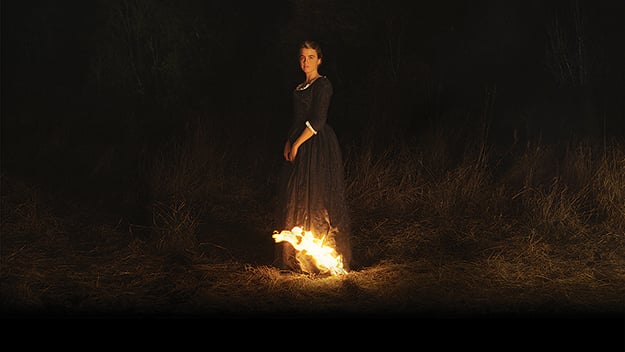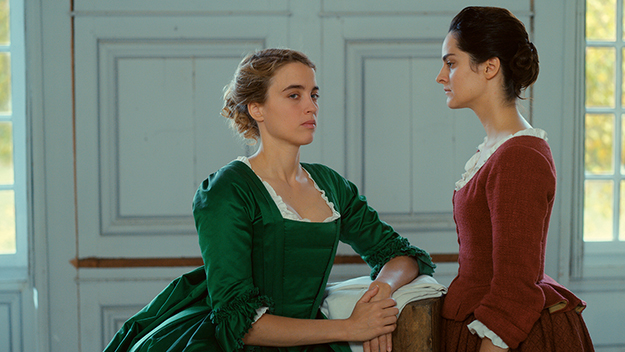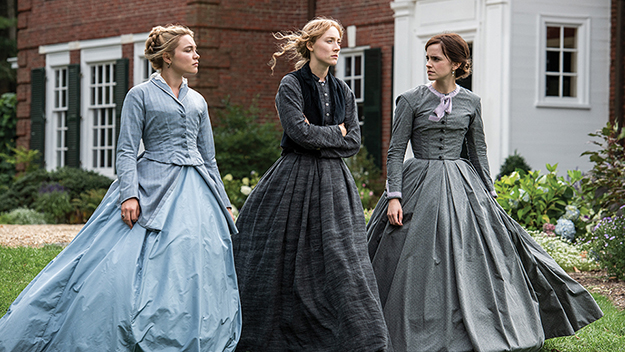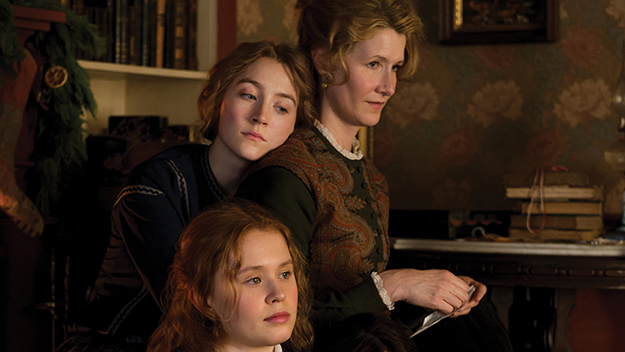Phantom Light: Portrait of a Lady on Fire and Little Women

Portrait of a Lady on Fire (Céline Sciamma, 2019)
Agnès Varda (the subject of a retrospective at Film at Lincoln Center) devoted much of her best work to looking at women: at their bodies and inner lives, their friendships and loves, how they move through the world and see themselves being seen, at her own career and her fertile, restless imagination. Women looking at women remain rare behind or in front of the camera, but two new movies written and directed by female filmmakers dwell on the emotional bonds between women, and on the choice—or lack thereof—between the paths of marriage and of artistic and professional independence. Both craft unabashedly beautiful visions of the past, and both are structured around the act of memory and the awareness of loss.
In Céline Sciamma’s Portrait of a Lady on Fire (2019), the painter Marianne (Noémie Merlant) recalls her visit, some years earlier, to a remote manor on an island in Brittany where she was hired to paint a young woman’s portrait. Set in the 1770s, the story at first conjures Gothic conventions: the big house where she arrives is forbidding, filled with shadows and shrouded furniture, haunted by the mysterious death of a girl who threw herself off the nearby cliffs. Her surviving sister, Héloïse (the ravishingly intelligent Adèle Haenel), Marianne’s intended subject, is elusive; first viewed from behind, she is as enigmatic a figure as Madeleine in Vertigo—a comparison suggested by her blonde chignon and emerald-green dress. She refused to pose for a previous male painter, who left behind a canvas with a finished body and a blank where the head should be, as though her face were vaporizing into smoke. Her mother proposes that Marianne paint her secretly, while pretending to be merely a companion for her daily walks, so her initial observations and sketches are furtive.
From the opening scene, in which Marianne serves as a model for her female drawing students, the act of observing, the exploratory and caressing gaze, is both the movie’s subject and its guiding principle. We often see Marianne at work (her convincingly-period paintings were created by Hélène Delmaire, whose hands appear on camera), and the whole film shares the sensuality of drawing, an act of both looking and vicariously touching. Sciamma and cinematographer Claire Mathon give the film the luscious, tactile beauty of an oil painting. Kitchen scenes have the tender earthiness of Chardin still lifes; landscapes on the rocky, blustery coasts combine autumnal, dying-fire hues with the otherworldly mists of sea-spray. Much attention is given to clothes: Marianne’s one dress of rust-red wool; Héloïse’s dark-green silk, and the wedding gown that haunts both women, a ghostly premonition of the future.

Héloïse does not want to pose because the portrait’s purpose is to advertise her to a potential husband whom she has never met. But when Marianne destroys her first attempt, a highly polished and conventional work that captures her subject’s features but none of her personality, Héloïse agrees to sit: a challenge more than an acquiescence. The sessions are a vehicle for their wary sparring and mutual fascination; in a key moment, when Marianne reveals how well she knows Héloïse’s mannerisms and quirks, the muse turns the tables, pointing out that while posing she has been observing the painter just as closely. The two are a study in contrasts, Marianne’s dark, sharp features setting off Héloïse’s blonde, classical beauty. The artist has independence and a certain masculine swagger—smoking a pipe and, in an early scene, plunging into the ocean to rescue a canvas that falls out of a boat. But the convent girl proves strong-willed, curious, and hungry for experience and sensation. Neither one is the pursuer or the seducer; they meet on terms of equality, in their physical attraction as much as in their intellectual communion.
This lesbian love story is set in a world from which men are almost totally absent, appearing on screen only peripherally. Some males who are never seen play significant parts: Marianne’s father, a painter who bequeathed his career to her; Héloïse’s prospective husband; the unnamed man who impregnated Sophie (Luàna Bajrami), the maid who gradually becomes a third major character. But while their power to change the women’s lives is felt, men are never much on their minds. At the center of the film is an idyllic interlude when Héloïse’s mother goes away, and the three young women are left to their own devices, enjoying a fleeting taste of freedom. They attend an alluringly coven-like gathering on the beach at night, where Breton women encircle a bonfire and sing a wild, sweet chorus; it is here that Héloïse’s skirt catches flame, providing the poetic and ominous image that Marianne will later paint. The two upper-class women accompany Sophie to the home of a village crone to undergo an abortion, performed in the presence of two small, untroubled children. Later, bizarrely, Héloïse drags the convalescent girl out of bed to reenact this scene of occult female intimacy so that Marianne can immortalize it in a sketch.
Conscious that their time together will be brief, the lovers become increasingly preoccupied with how they will remember it. Marianne creates miniature portraits for each of them to take away; Héloïse foresees that “eventually you’ll see her when you think of me.” They read Ovid’s tale of Orpheus and Eurydice, arguing about why he forfeits the chance to bring his wife back from the dead; does he choose her memory over her future, “not the lover’s choice but the poet’s”? Or is it she who tells him to let her go? The coda to the film, with its neatly constructed postscripts filled with echoes and coincidences, is emotionally plangent but feels over-determined, and relies on the anachronistic fantasy that women in the late 18th century could attend the theater unchaperoned. But there is nothing fantastic in the idea of a woman of that time making her living as a painter: Sciamma has said that she was inspired by the lives of real female artists like Elisabeth Vigée Le Brun and Artemisia Gentileschi, and even more by the many others who have been forgotten or written out of histories.

Little Women (Greta Gerwig, 2019)
Greta Gerwig’s new adaptation of Little Women (2019) foregrounds Jo March’s emergence as a professional author, often erasing the gap between the fictional heroine and her creator, Louisa May Alcott. This “meta” approach has several advantages: it acknowledges the book’s status as a known-by-heart cultural icon and the movie’s place in a lineage of adaptations, and it also allows Gerwig to stiffen the book’s feminist spine without being unfaithful to the realities of the era. Little Women was substantially autobiographical, so it feels right that the script gives Jo some lines drawn from Alcott’s letters and diaries (for instance, “I’d rather be a free spinster and paddle my own canoe”). It is impossible to consider the book today without thinking of all the women—from Simone de Bouvoir to Susan Sontag—who have seen themselves in Jo: not the rambunctious tomboy who is ultimately tamed into marriage, but the girl who scribbles in the attic and feels the fierce joy of selling her first story. In Gerwig’s film this legacy shines through the story, at times creating a palimpsest of the text and the ideas it has inspired.
The most obvious way this latest Little Women differs from earlier versions is in its time scheme: rather than opening with the expected Christmas-without-any-presents, it begins with Jo (Saoirse Ronan) living in on her own in New York. Scenes from the book’s first part, when she was at home with her sisters—the dances and homemade theatricals, Jo scorching Meg’s hair with a curling iron, Amy burning Jo’s manuscript—are summoned as memories, sometimes out of order. This structure relies to a degree on the fact that many viewers, even if they have not read the book, will know the story and characters, and it successfully brings a sense of freshness alongside the welcome return of the familiar and beloved. The technique highlights doublings between the first and second halves of the story, for instance, two scenes at the beach—the first an idyllic vision of swirling summer crowds, the second isolated and piercingly sad; both elegantly conjuring the imagery of Winslow Homer.
Most daringly, the film intercuts the first illness of Beth (Eliza Scanlen) with her final decline and death, so that instead of the suspense and relief usually built into her initial bout of scarlet fever, the past is colored by the knowledge both that she will recover, and that the recovery will prove short-lived. Instead of seeing Laurie (Timothée Chalamet) fall in love with, propose to, and be rejected by Jo, then later fall in love with, propose to, and be accepted by Amy (Florence Pugh), we get the two relationships interwoven, and see his attraction to Amy even before his devotion to Jo has been fully established. This emphasis—which makes the union of Laurie and Amy far more credible and sympathetic than most adaptations—goes along with the movie’s shift of focus towards the characters as adults. The bright, warm colors and dynamic energy of the flashbacks feels like a concentrated vision of youth filtered through the darker tones and more complex feelings of adulthood. A scene illustrating strains in the marriage between Meg (Emma Watson) and John Brooke (James Norton) provides a rare glimpse beyond “happy ever after.” It also reiterates the film’s constant refrain: that money, or the lack of it, is at the root of this story.

The film confronts head-on the book’s most glaring flaw to contemporary eyes: the way it forces Jo, who has railed against marriage, to wind up with a husband—and what’s more, with the man whose criticism has encouraged her to quit writing. Alcott stated that Jo “should have remained a literary spinster,” as she did herself, but that so many readers were clamoring for her to get married (preferably to Laurie) that she gave in; she refused, however, to let her wed the boy the next door, instead concocting a “funny match” for her heroine. Professor Friedrich Bhaer is cultured, serious, and kind, but few readers have been satisfied with this stout, middle-aged, avuncular figure with a comical German accent as a romantic prospect. Gillian Armstrong’s much-loved 1994 adaptation solved the problem by casting Gabriel Byrne and transforming Bhaer into a smoldering, poetic lover. Gerwig cleverly manages to have her cake and eat it too. At first she seems to be going to even greater lengths to improve on Bhaer with the casting of Louis Garrel, who is young, French, and conspicuously attractive. In the end, however, the climactic reunion and kiss in the rain are played with a knowing wink, intercut with a scene in which Jo, in the office of her publisher, pragmatically agrees to marry off her heroine to boost sales, noting that, “Marriage is always an economic proposition, even in fiction.”
This Little Women is all the better for wearing its heart, and its feminism, on its sleeve; but ultimately what elevates it are the multi-dimensional representations of characters who are too easily flattened to types. Laura Dern’s Marmee is less tiresomely idealized and didactic than usual; she weeps helplessly when Beth dies, and reveals (as she does in the book) that she is “angry nearly every day of my life.” Meryl Streep’s Aunt March is less a pompous tyrant than a tart cynic; Emma Watson’s Meg shows the dissatisfaction and weakness within the domestic angel; Eliza Scanlen’s Beth is not annoyingly saintly. Most strikingly, Florence Pugh’s Amy is not the caricature of vanity and immaturity that she has often been reduced to, but strong-willed, unillusioned, and angry—she becomes almost as central a character as Jo, the sister to whom she complains she has always been second in everything. As for Jo, Saoirse Ronan makes her effortlessly irresistible: swashbuckling, violently quick-tempered, determined, loving.
Several times, the camera catches the men from next door—old Mr. Laurence, Laurie, and his tutor Mr. Brooke—standing around watching the women of the March household in their impenetrable, dazzling whirlwind of female energy and intimacy. What we see in these moments is a very different kind of male gaze, a wistful envy, a sense of being left out. Stirringly, this is a film in which no one is vilified, and everyone is allowed their vulnerabilities and failings. In an impassioned speech (drawn from another of Alcott’s works, with a key addition by Gerwig), Jo protests how sick she is of hearing that women—with all their intelligence, talents, and ambitions—are fit only for love, yet concludes with desperate honesty: “But I’m so lonely.”
“Being free is being alone?” Héloïse asks in Portrait of a Lady on Fire. For women, that remains the question.
Imogen Sara Smith is the author of In Lonely Places: Film Noir Beyond the City and Buster Keaton: The Persistence of Comedy, and has written for The Criterion Collection and elsewhere. Phantom Light is her regular column for Film Comment.







